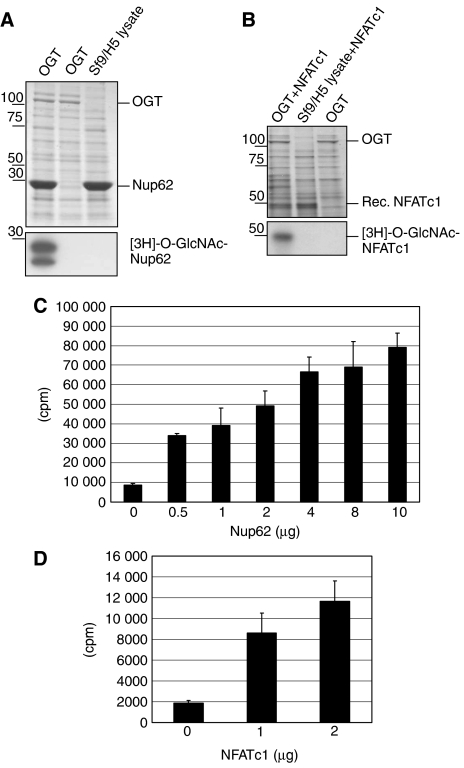Figure 6.
NFATc1 is O-GlcNAc-modified by OGT in vitro. An O-GlcNAc transferase assay was developed using a Sf9/H5 lysate containing enriched OGT expressed by baculovirus. Recombinant Nup62 was used as a control substrate for OGT. (A) Upper panel: Coomassie brilliant blue stained SDS–PAGE gel of whole reaction mix (Sf9/H5 lysates with or without OGT and Nup62). Lower panel: the gel (the portion containing Nup62 is shown) was processed to autoradiography after incubation of the lysate containing OGT or lysate from Sf9 cell infected with a control virus (Sf9 lysate) with UDP-[3H]GlcNAc. (B) Upper panel: Coomassie brilliant blue stained SDS–PAGE gel of whole reaction mix (Sf9/H5 lysates with or without OGT and recombinant NFATc1). Lower panel: the gel (the portion containing recombinant NFATc1 is shown) was processed to autoradiography after incubation with UDP-[3H]GlcNAc of the lysate containing OGT or lysate from Sf9 cells infected with a control virus (Sf9 lysate). (C) The O-GlcNAc transferase assay was performed as described in (A) with 0–10 μg purified Nup62. The reaction mixture was precipitated by TCA and the radioactivity associated with the pellet counted. The amount of radioactivity associated with the TCA precipitate correlates with the amount of Nup62 present in the transferase reaction. (D) An assay similar to that described in (B) was performed with 0, 1 and 2 μg of recombinant NFATc1. The reaction mixture was precipitated by TCA and the radioactivity associated with the pellet counted. The amount of radioactivity associated with the TCA precipitate correlates with the amount of NFATc1 present in the transferase reaction.

